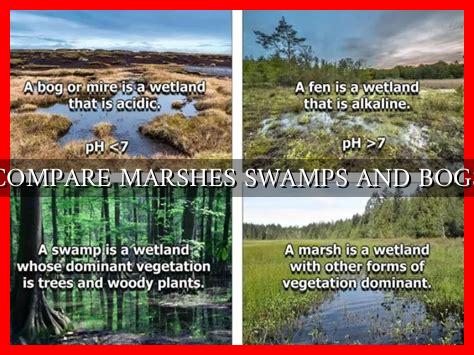-
Table of Contents
Comparing Marshes, Swamps, and Bogs
Wetlands are vital ecosystems that play a crucial role in maintaining biodiversity and providing various ecological services. Among the different types of wetlands, marshes, swamps, and bogs are commonly found across the world. While they may appear similar at first glance, each of these wetland types has unique characteristics that set them apart. In this article, we will compare marshes, swamps, and bogs to understand their differences and similarities.
Marshes
Marshes are wetlands characterized by shallow water and a high concentration of grasses, reeds, and other herbaceous plants. They are typically found along the edges of rivers, lakes, and coastlines.
. Marshes are known for their rich biodiversity, providing habitat for a wide range of plant and animal species.
- Marshes are often divided into two main types: saltwater marshes and freshwater marshes.
- Examples of famous marshes include the Everglades in Florida and the Camargue in France.
Swamps
Swamps are wetlands characterized by standing water and dominated by trees and shrubs. They are typically found in low-lying areas with poor drainage. Swamps are known for their high productivity and serve as important habitats for various wildlife species.
- Swamps can be further classified into different types, such as freshwater swamps, saltwater swamps, and mangrove swamps.
- The Okefenokee Swamp in Georgia and the Pantanal in South America are examples of famous swamps.
Bogs
Bogs are wetlands characterized by acidic, nutrient-poor conditions and dominated by peat mosses and other sphagnum mosses. They are typically found in cool, northern regions and are known for their unique plant communities, including carnivorous plants like sundews and pitcher plants.
- Bogs are often referred to as “peatlands” due to the accumulation of peat, a type of organic soil material.
- Famous bogs include the Great Dismal Swamp in Virginia and the Tregaron Bog in Wales.
Key Differences
While marshes, swamps, and bogs are all types of wetlands, they have distinct characteristics that differentiate them from each other:
- Marshes are characterized by shallow water and herbaceous plants, while swamps have standing water and are dominated by trees and shrubs.
- Bogs have acidic, nutrient-poor conditions and are dominated by peat mosses, unlike marshes and swamps.
Importance of Wetlands
Wetlands, including marshes, swamps, and bogs, play a crucial role in maintaining ecological balance and providing various benefits to humans and wildlife. They help regulate water flow, improve water quality, and provide habitat for numerous plant and animal species.
According to the Environmental Protection Agency (EPA), wetlands also serve as carbon sinks, storing significant amounts of carbon and helping mitigate climate change.
Conclusion
In conclusion, marshes, swamps, and bogs are important types of wetlands with unique characteristics that make them valuable ecosystems. Understanding the differences between these wetland types is essential for conservation efforts and sustainable management of these vital habitats. By protecting and preserving marshes, swamps, and bogs, we can ensure the continued health and biodiversity of our planet’s wetlands.





